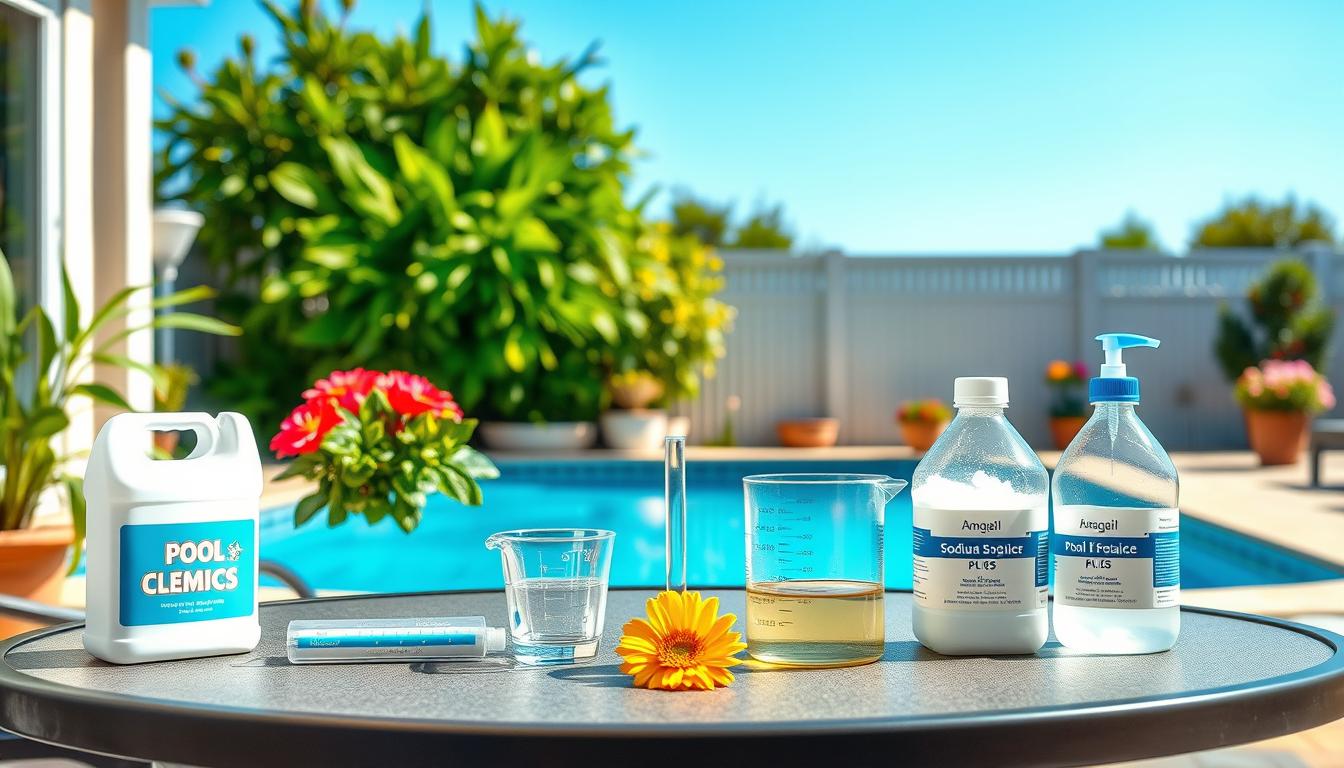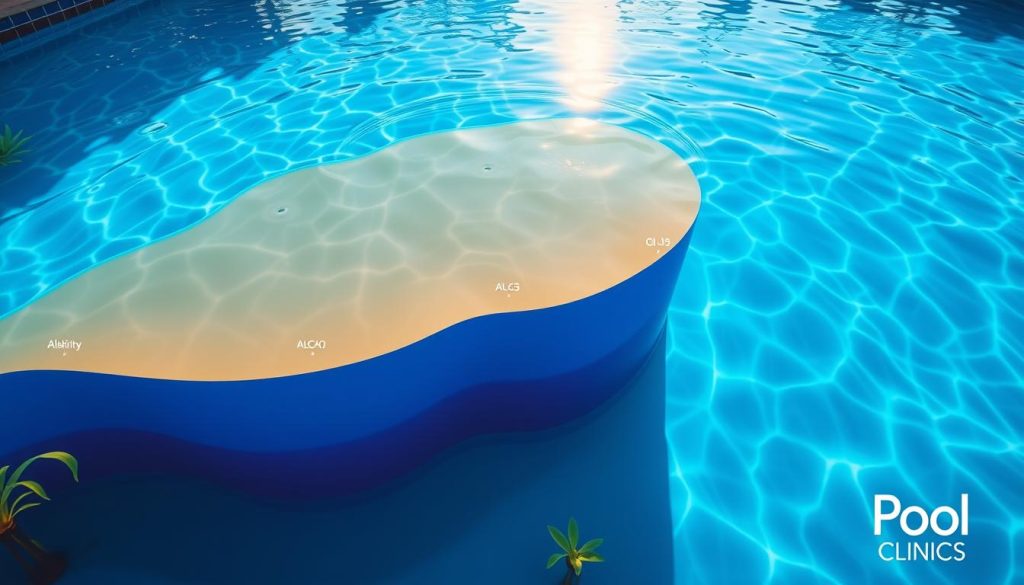
Maintaining a perfect pool can be challenging. Low alkalinity is a common issue that can cause problems. It can weaken chlorine, irritate eyes, and damage pool components.
This guide explores the importance of proper alkalinity levels. We’ll look at causes and effects of low alkalinity. You’ll also learn practical solutions to fix this issue.
Our step-by-step guide will help you tackle low alkalinity. You’ll be ready to enjoy worry-free swimming all season long.
Key Takeaways
- Total alkalinity is a measure of alkaline substances in pool water that act as buffers to resist pH change.
- The recommended range for a swimming pool’s total alkalinity is between 80 and 120 parts per million (ppm).
- Low alkalinity can diminish chlorine’s effectiveness, cause eye irritation, metal corrosion, and potential staining of the pool finish.
- Common causes of low alkalinity include heavy rainfall, excessive chlorine use, and improper pH balance.
- Solutions for raising low alkalinity include using sodium bicarbonate (baking soda) or alkalinity increaser, following a step-by-step guide, and maintaining proper levels through regular testing and adjustments.
What is Total Alkalinity and Why is it Important?
Total alkalinity is a key factor in pool maintenance. It keeps pool water balanced and safe for swimming. Understanding it is crucial for every pool owner.

Total Alkalinity Defined
Total alkalinity measures alkaline substances in pool water. These include bicarbonates, carbonates, and hydroxides. They act as a buffer to keep pH levels stable.
This stability prevents rapid pH changes. Such changes can cause various issues in your pool.
The Role of Total Alkalinity in Maintaining Pool Water Balance
Proper total alkalinity is vital for several reasons:
- It keeps pH levels stable, preventing skin and eye irritation. It also protects pool equipment from damage.
- It enhances the effectiveness of chlorine and other sanitizers. This keeps your pool clean and safe.
- It protects pool surfaces and equipment from corrosion. Acidic water can cause this damage.
Balanced total alkalinity improves your swimming experience. It also extends the life of your pool and its parts.
Recommended Total Alkalinity Levels
The ideal range for total alkalinity is 80 to 120 parts per million (ppm). This range ensures optimal pH stability and pool health.
Regular testing with a reliable kit is important. It helps maintain the right total alkalinity range.
| Total Alkalinity Range | Effect on Pool Water |
|---|---|
| Below 80 ppm | Rapid pH fluctuations, corrosion, and irritation |
| 80-120 ppm | Ideal range for balanced pool water |
| Above 120 ppm | Difficult pH adjustment, cloudy water, and reduced sanitizer efficiency |
“Maintaining proper total alkalinity levels is the foundation for a healthy, balanced pool. It’s a small step that makes a big difference in our swimming experience.”
Keeping total alkalinity in check is crucial. It ensures your pool remains safe and enjoyable for years.
Causes and Effects of Low Pool Alkalinity
Low alkalinity in pools can cause various problems. It affects pool health, appearance, and swimmer safety. Understanding its causes and effects is vital for proper pool maintenance.
Common Causes of Low Alkalinity in Pools
Several factors can lead to low alkalinity in your pool. These include excessive rainfall, improper maintenance, and certain chemicals.
Frequent splashing or water evaporation can also decrease alkalinity over time. Regular testing and adjustments are crucial to maintain proper levels.
Consequences of Low Alkalinity Levels
- Rapid pH fluctuations, making it difficult to maintain stable water chemistry
- Chlorine inefficiency, as low alkalinity can render sanitizers less effective at combating bacteria and algae
- Metal corrosion, as acidic water can damage pool equipment, such as pumps, filters, and heaters
- Pool staining, as low alkalinity can cause minerals to precipitate and leave unsightly stains on pool surfaces
- Skin and eye irritation for swimmers, due to the acidic nature of the water
Signs of Low Alkalinity in Your Pool
Spotting low alkalinity early helps prevent serious issues. Common signs include cloudy water, rough surfaces, and reduced circulation.
If you’re constantly adjusting pH levels, it may indicate low alkalinity. Regular testing can help maintain a balanced pool environment.
| Sign | Description |
|---|---|
| Cloudy water | Low alkalinity can cause your pool water to appear hazy or cloudy, as it becomes more difficult for sanitizers to work effectively. |
| Rough surfaces | Acidic water can erode pool surfaces, leading to a rough or etched feeling on the walls and floor of your pool. |
| Reduced circulation | Low alkalinity can cause scale buildup in your pool’s plumbing, restricting water flow and reducing overall circulation. |
| Rapid pH changes | If you find yourself constantly adjusting the pH levels in your pool, it may be a sign that your alkalinity is too low. |
Maintaining balanced alkalinity is key to a healthy pool. Regular testing and adjustments help avoid negative consequences.
Proper pool maintenance ensures a safe and enjoyable swimming experience. Stay vigilant and address low alkalinity promptly for best results.
Solutions for Raising Low Pool Alkalinity
First, check your pool’s alkalinity levels with a reliable testing kit. If it’s low, take steps to raise it. The recommended range is 80-120 ppm.
Testing Your Pool’s Alkalinity
Use a high-quality pool testing kit to check alkalinity levels. These kits are easy to find at pool supply stores. Follow the instructions carefully for accurate results.
Using Sodium Bicarbonate (Baking Soda) to Raise Alkalinity
Baking soda is a cost-effective way to raise pool alkalinity. Add 1.5 pounds per 10,000 gallons to increase alkalinity by 10 ppm. The exact amount may vary based on your pool’s conditions.
Step-by-Step Guide to Raising Pool Alkalinity
To raise alkalinity with sodium bicarbonate, follow these steps:
1. Calculate the needed amount based on your pool’s volume.
2. Pour the baking soda into the pool while the pump runs.
3. Brush the pool to help dissolve the baking soda.
4. Let the pool circulate for 24 hours before retesting.
5. Repeat if needed to reach the desired alkalinity level.
Tips for Maintaining Proper Alkalinity Levels
Test alkalinity levels weekly as part of your pool maintenance. Make small adjustments to avoid over-correcting. Keep a log of chemical levels and adjustments made.
Consider using an automatic pH and alkalinity controller. This can help minimize fluctuations and reduce manual adjustments.
When to Seek Professional Help
If you’re unsure about testing pool alkalinity or handling chemicals, consult a professional. They can help with persistent issues or imbalances. A pro ensures a safe and enjoyable swimming environment.







